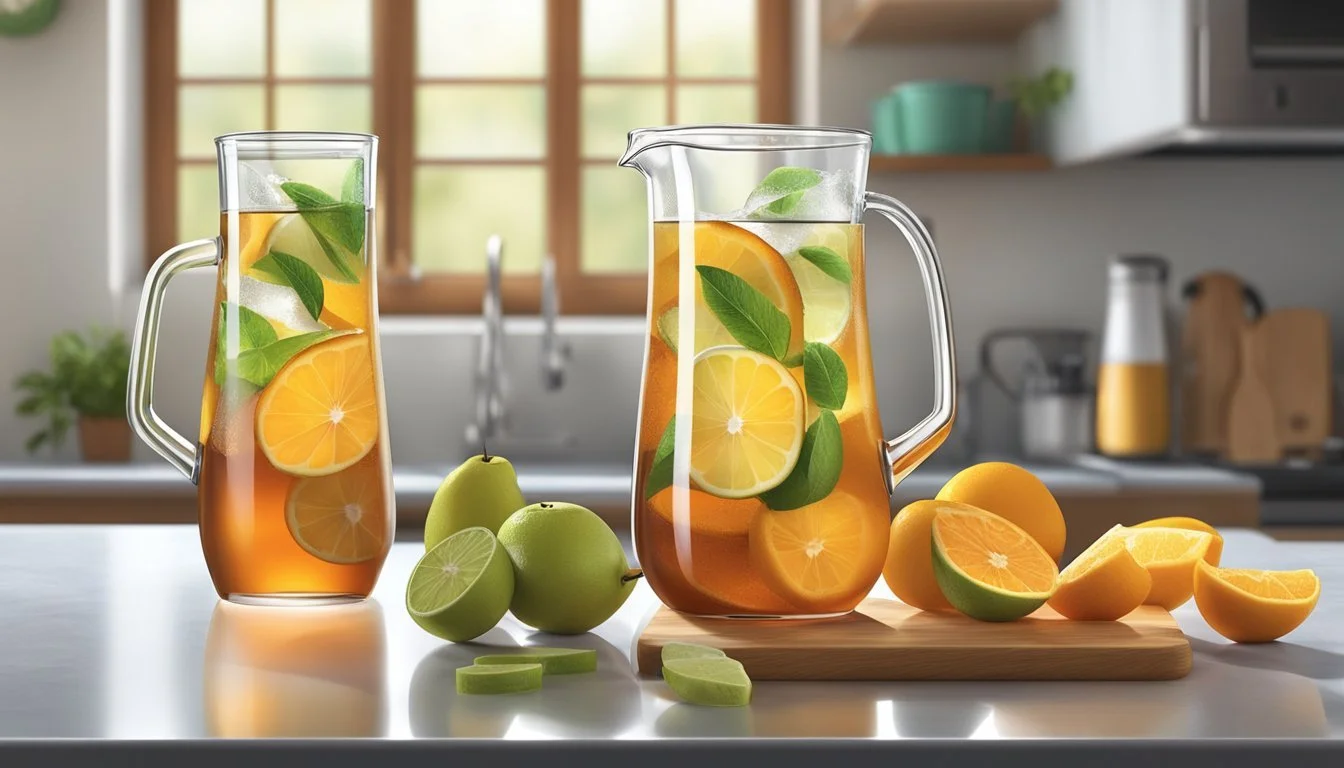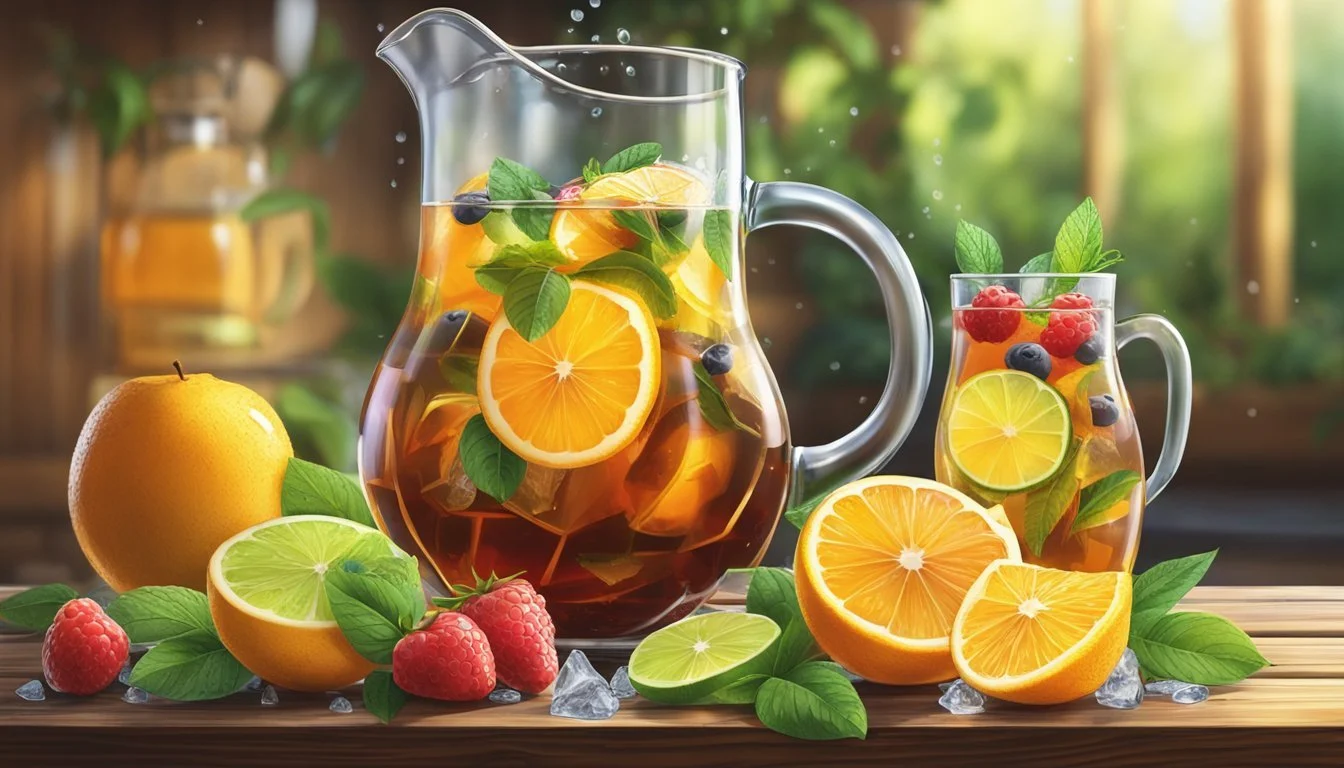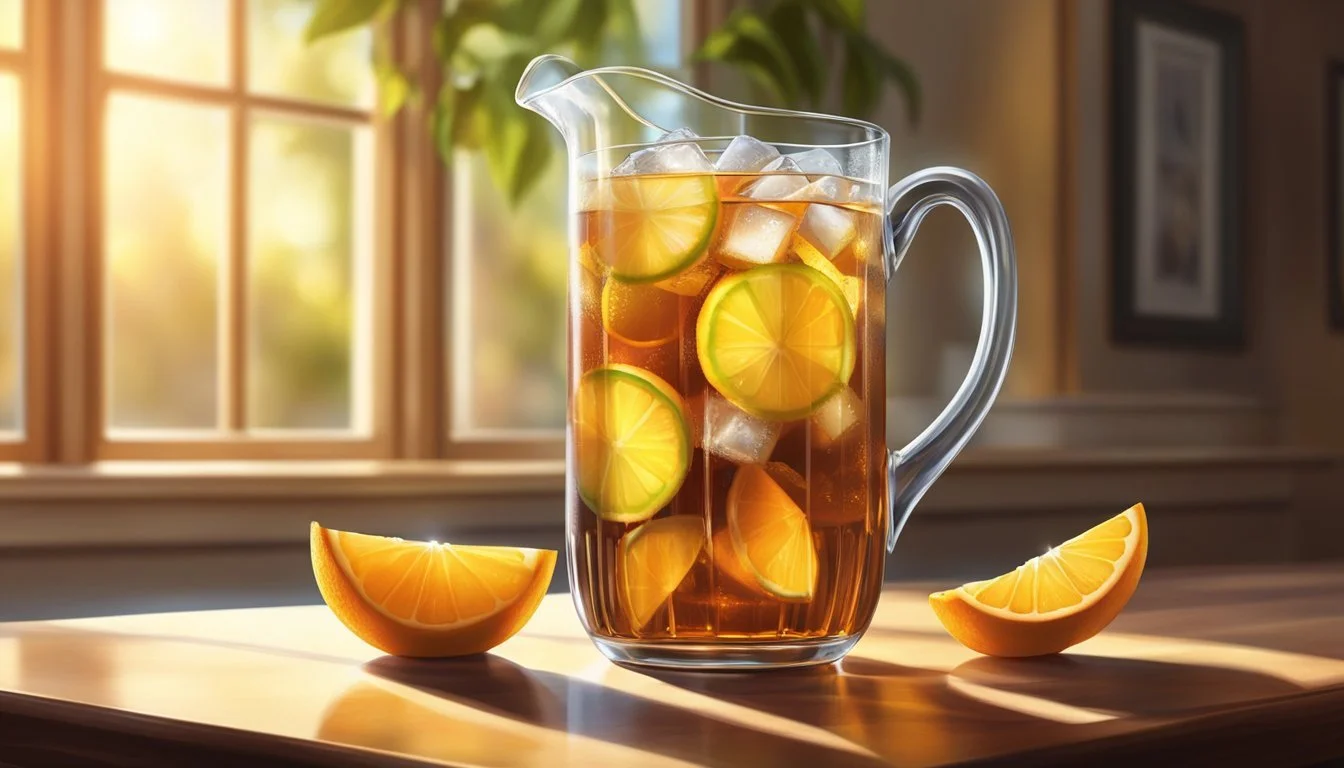How Long Does Freshly Prepared Iced Tea with Fruit Infusions Last?
Understanding Shelf Life and Storage Tips
When the heat of summer settles in, many find solace in the refreshing embrace of freshly brewed iced tea. This chilled beverage, often infused with an assortment of fruits (What wine goes well with fruit?), offers a cool escape and a burst of flavor. However, the introduction of fresh fruits can impact the longevity of iced tea's freshness. The perishability of these natural additions requires a careful consideration of how long the iced tea remains suitable for consumption.
The shelf life of fruit-infused iced tea is generally shorter than its plain counterpart due to the presence of organic matter which can accelerate spoilage. Ideally, such a concoction should be consumed within 1 to 2 days to ensure optimal freshness and safety. This timeframe can vary depending on the types of fruits used and how the infusion is prepared. Storing the beverage properly in the refrigerator is key to maintaining its quality, as it slows down the growth of bacteria and preserves the flavors of the tea and fruit infusion.
Ensuring the extended life of iced tea with fruit infusions involves precautions such as removing the fruit after a few hours or straining the tea before chilling. Doing so can help to strike a balance between robust flavor and beverage longevity, allowing for enjoyment over a few days. Those who prepare such beverages should be aware of signs of spoilage including changes in taste, smell, or appearance, which indicate it's time to discard the tea.
Importance of Storage Conditions
The longevity of freshly prepared iced tea with fruit infusions hinges on how it is stored. Precise temperature control, protection from light, and minimizing air exposure in a refrigerator are critical factors affecting shelf life.
Temperature and Light
Temperature: Freshly prepared iced tea with fruit infusions should be stored at a consistent, cold temperature to inhibit bacterial growth. The ideal storage temperature is within the refrigerator's range of 35°F to 38°F.
Light: Avoid exposing iced tea to direct sunlight or harsh indoor lighting, as UV rays and heat can cause degradation of flavors and increase the risk of spoilage.
Air Exposure
Limiting the amount of air that comes into contact with the iced tea is essential for preserving taste and extending shelf life. Storing the tea in an airtight container helps maintain its quality by preventing oxidation and contamination from external smells and flavors.
Refrigeration Necessities
Refrigeration is a must for maintaining the quality of iced tea with fruit infusions. One should store the beverage in a refrigerator shortly after preparation to keep it fresh. Environmental factors such as heat and humidity are greatly diminished in the cool and stable environment of a refrigerator, significantly prolonging the tea's shelf life compared to room temperature storage.
Spoilage Factors
When considering the lifespan of freshly prepared iced tea with fruit infusions, the following factors greatly affect its safety and quality. They determine the timeframe in which the beverage should be consumed to avoid spoilage and the health risks associated with spoiled drinks.
Bacteria and Mold Risks
Bacteria and mold thrive in moist, nutrient-rich environments. Iced tea with fruit infusions provides such an environment, hence it is prone to microbial growth. The risks increase when tea is stored at room temperature or for longer periods than recommended. Ensuring the tea is kept refrigerated and consumed swiftly can mitigate the risk of bacteria and mold development.
Visual and Olfactory Spoilage Indicators
The primary signs of spoilage include changes in color, smell, or taste. Common indicators are:
Cloudiness: A visual hint of bacterial or mold proliferation.
Off-odors: A sour or unusual smell is a clear signal that the tea is no longer safe to consume.
Taste alteration: Any off-flavors are a final confirmation that spoilage has occurred.
These signs help assess whether the iced tea has gone bad, beyond just the date it was created.
Health Implications of Consuming Spoiled Tea
Health risks resulting from consuming spoiled iced tea can vary from mild gastrointestinal discomfort to more severe foodborne illnesses. Microbial growth, particularly of pathogenic bacteria, can lead to infections that require medical attention. It is crucial to heed spoilage indicators to prevent the health implications of ingesting compromised iced tea.
Optimal Freshness Duration
For those seeking to enjoy freshly prepared iced tea with fruit infusions at its peak, understanding the optimal freshness duration is crucial. This section will discuss the shelf life of homemade iced tea and the impact of preservatives on extending that shelf life.
Shelf Life of Homemade Iced Tea
Homemade iced tea, infused with the delicate nuances of fresh fruit, is best enjoyed within 3 to 4 days when refrigerated. This limited time frame ensures the tea maintains its refreshing taste and that it remains safe to drink. Freshness starts to decline beyond this period due to the absence of preservatives, and the tea may develop unpleasant flavors or potentially harmful bacterial growth.
Preservatives and Shelf Life Extension
The introduction of preservatives can greatly extend an iced tea's shelf life. Commercial iced teas often contain these substances, which allow them to remain fresh and safe to consume for more extended periods. When preparing iced tea at home, the lack of these preservatives means a shorter shelf life but also means a more natural taste profile, devoid of any chemical additives.
Ingredients Impact
The longevity of freshly prepared iced tea with fruit infusions is significantly influenced by the ingredients used in its preparation. The selection of ingredients can alter the shelf life, freshness, and stabilization of the iced tea.
Role of Ingredients in Longevity
The freshness and longevity of iced tea are directly affected by the types of ingredients included. Fresh fruits and herbs, while enriching the flavor, can also introduce microorganisms that may hasten spoilage. Sugar and other sweeteners, when added, can sometimes act as natural preservatives to an extent by creating an environment less hospitable to bacterial growth. However, sweeteners can also make the drink more prone to spoilage if they are contaminated with moisture or impurities.
The use of tea bags instead of loose leaf tea can have an indirect effect; tea bags often contain smaller particles that infuse quickly but can also result in a cloudier tea which may impact perceived freshness. When considering natural preservatives, options like lemon juice or ascorbic acid (vitamin C) can extend shelf life by providing acidity which inhibits bacterial growth.
Effect of Additives on Freshness
Additives play a pivotal role in determining the freshness of iced tea infusions. Natural additives like lemon juice or ascorbic acid can serve to maintain the color and flavor integrity of the iced tea while making it less prone to spoilage. Conversely, the introduction of fresh fruit into the infusion can be a double-edged sword, enriching the taste but also shortening the tea's shelf life due to the fruit's organic degradation.
It's critical to consider the moisture content and potential microbial presence in all additives. For instance, herbs introduced into the iced tea must be thoroughly washed and possibly even blanched to minimize bacterial content. Furthermore, the quality of water and the sanitation of preparation containers play a crucial role in the longevity and freshness of the final product.
Preparation and Handling
The longevity of freshly prepared iced tea with fruit infusions hinges on the brewing method, meticulous mixing, and stringent sanitation standards.
Iced Tea Brewing Methods
One typically begins by brewing tea using traditional hot methods or a cold brew process. Hot brewing involves steeping tea bags or loose leaves in freshly boiled water, allowing the flavors to develop rapidly. For cold brewing, tea bags or an infuser with loose leaves are submerged in room-temperature water and left to steep in the refrigerator for a period ranging from 12 to 24 hours. Cold brewing typically results in a smoother, less bitter tea.
Mixing and Infusion Techniques
After the tea is brewed, fruit infusions can be introduced.
Direct Addition: Sliced or diced fruits are added into a pitcher of brewed tea.
Muddling: Fruits are crushed at the bottom of the pitcher before the brewed tea is poured in, releasing more of their flavors.
Infuser Use: An infuser or mesh bag can hold the fruit, which is then placed in the tea to steep.
Whichever method is used, stirring helps to mix the fruit flavors evenly throughout the tea.
Sanitation and Equipment
Cleanliness is crucial in extending the freshness of iced tea with fruit infusions. Equipment should be sterilized before use, including the pitcher, infuser, or any utensils. It's critical that:
All equipment is clean and free from residue.
Hands are washed thoroughly before handling ingredients or equipment.
This prevents the introduction of bacteria that could spoil the tea. Brewed tea, especially with added fruit, should always be stored in the refrigerator within two hours of preparation to maintain its quality and safety.
Flavor and Quality Retention
When it comes to freshly prepared iced tea with fruit infusions, retaining the beverage's flavor and quality is paramount. This section details how one can maintain the tea's flavor profile and nutritional benefits after preparation.
Preserving Flavor Profile
To preserve the flavor profile of iced tea with fruit infusions, it is essential to store the beverage in a sealed container in the refrigerator. The cool environment helps to slow down the degradation of the flavor compounds. Iced tea should be consumed within 3 to 4 days to enjoy its optimal taste, as beyond this period, the nuanced flavors of both the tea and the fruit may begin to deteriorate. Using fresh, high-quality ingredients and proper ratios for the initial brew will further ensure a robust and lasting flavor profile.
Maintaining Nutritional Benefits
The nutritional benefits of iced tea, particularly its antioxidants, are best maintained by storing the tea at a cool temperature. Refrigeration not only preserves the tea's taste but also helps retain its nutritional content. Antioxidants such as polyphenols can degrade over time; therefore, consuming the iced tea within the recommended timeframe is also crucial for maximizing these health benefits. The fruits added for infusion contribute additional nutritional benefits, including vitamins and minerals, although their potency may similarly reduce if the tea is stored for too long.
Types of Teas and Infusions
Tea types vary in flavor, processing, and properties, and the addition of fruits and herbs into infusions can further extend their flavor profiles and potential health benefits.
Differences in Tea Varieties
Black Tea: Produced through full oxidation, black tea is known for its robust flavor and higher caffeine content. Common blends include Earl Grey and Chai.
Green Tea: Less oxidized than black tea, green tea offers a delicate taste and is often associated with a wide range of health benefits due to its antioxidants.
White Tea: The least processed tea variety, white tea is prized for its mild, sweet flavor and contains both lower caffeine levels and a high antioxidant count.
Herbal Tea: Not a true tea as it does not come from the Camellia sinensis plant, herbal tea includes infusions made from herbs, spices, or other plants such as mint or lemon.
Fruit and Herb Infusions
Mint: Often paired with green tea, mint infusions are refreshing and can aid digestion.
Ingredients for Fruit and Herb-Infused Tea:
Fruit/Herb Tea Pairing Notes Lemon Black, Green Adds a refreshing zestiness. Berries Black, Herbal Provide natural sweetness and antioxidants.
Herb Mixtures: These can be infused alone or with a tea base, using ingredients like lavender to create calming blends.
In crafting infusions, the pairing of the tea type with the right fruit or herb can result in a beverage tailored for taste preferences or health considerations.
Additional Considerations
When it comes to enjoying freshly prepared iced tea with fruit infusions, there are several key points to consider beyond just the flavor and freshness. Readers should be aware of the caffeine content, the calorie implications of sweetening, and best practices for storing leftovers to retain the quality of their iced tea.
Caffeine Content and Its Effects
The caffeine content in fruit-infused iced tea depends largely on the type of tea leaves used. Black and green teas typically contain caffeine, which can provide a boost of energy but may also impact sleep if consumed late in the day. For those sensitive to caffeine or preferring a non-stimulating beverage, herbal teas or decaffeinated options are a suitable base for fruity infusions.
Calorie Considerations for Sweetened Iced Tea
Adding sweeteners to iced tea can significantly increase its calorie content. Common sweeteners include:
Sugar: High in calories.
Honey: A natural alternative with slightly fewer calories.
Syrups: Often contain a high level of calories.
For a lighter version, individuals might opt for zero-calorie sweeteners or enjoy the natural sweetness of the fruit.
Storage Tips for Leftover Iced Tea
Leftover fruit-infused iced tea should be properly stored to maintain its quality. Here are a few tips:
Glass Pitcher: Store in a glass pitcher covered with a lid to preserve flavor and prevent odors.
Refrigeration: Keep refrigerated and consume within 1-2 days for optimal taste.
Freeze: For longer storage, freeze in an ice cube tray and thaw when ready to drink.
Remove Fruit: To prevent over-steeping and spoilage, remove fruit pieces after a few hours.
Employing these considerations ensures the fruity iced tea remains a delightful and safe refreshment.









